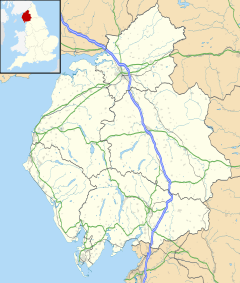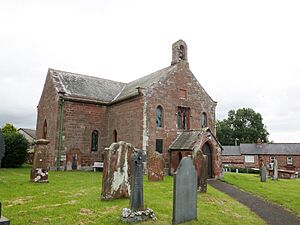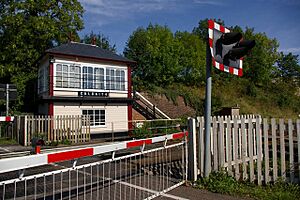Culgaith facts for kids
Quick facts for kids Culgaith |
|
|---|---|
| Village and parish | |
 An old Cumbrian farmhouse in Culgaith |
|
| Population | 826 (2011) |
| OS grid reference | NY6129 |
| Civil parish |
|
| Unitary authority |
|
| Ceremonial county | |
| Region | |
| Country | England |
| Sovereign state | United Kingdom |
| Post town | PENRITH |
| Postcode district | CA10 |
| Dialling code | 01768 |
| Police | Cumbria |
| Fire | Cumbria |
| Ambulance | North West |
| EU Parliament | North West England |
| UK Parliament |
|
Culgaith is a small village and a local area (called a civil parish) in the Westmorland and Furness region of Cumbria, in north west England. The village sits on a hill overlooking the River Eden. It is located between the villages of Temple Sowerby and Langwathby. In 2011, about 826 people lived in Culgaith.
The village has a few important places. These include All Saints Church, which has a primary school next to it. There is also a public house where people can meet. The village used to have its own railway station, but it closed in 1970.
Contents
What Does Culgaith Mean?
The name "Culgaith" most likely comes from an old language called Brythonic. This language was spoken in Britain a very long time ago.
The name seems to be made of two parts:
- *cūl: This part means 'corner' or 'a quiet place'. In modern Welsh, it became 'cil'.
- *koid: This part means 'wood'. In modern Welsh, it became 'coed'.
So, Culgaith might mean something like 'corner of the wood' or 'wooded retreat'. It could also mean 'narrow wood'.
Some people thought the name might come from Gaelic, meaning 'at the back of the wind' or 'windy nook'. However, the Brythonic origin is thought to be more likely.
Where is Culgaith Located?
The B6412 road connects Culgaith to other places. To the south, it links up with the A66 road. To the north west, it goes to the village of Langwathby. The larger town of Penrith is about 6 miles (10 km) to the west of Culgaith.
A Look Back at Culgaith's History
The village of Culgaith probably got its name from a person named Henry de Culgaith. He was a clerk who received land in Carlisle around the year 1296. His wife, Alice de Culgaith, later gave up her claim to some of this land.
Long ago, there was a small church in Culgaith. It was connected to a main church in Kirkland. At that time, a powerful person named Sir Michael de Hercla was the Lord of the Manor (the main landowner) in Culgaith. He was a knight who fought alongside King Edward I in wars against Scotland. He was even at a famous castle siege in 1300.
Later, Sir Michael had problems with the King. His son, Andrew de Hercla, also angered the new King Edward II. Because of this, the ownership of the manor of Culgaith changed hands several times. A wood in Culgaith, called Kirklandres, was given to monks in York. During a time of civil war in England, known as the Wars of the Roses, the manor was transferred to the Priory of Carlisle.
A grammar school (a type of school that taught Latin and Greek) was started in the village. It was for children from Culgaith and a nearby area called Blencarn. Land from Culgaith was also used to help start the Barton Grammar School.
By 1811, the population of Culgaith was counted along with nearby areas like Kirkland, Blencarn, and Skirwith. There were 141 houses and 608 people living in the area. For a long time, the population did not grow much. During the Industrial Revolution, Culgaith was mostly a farming area. Most of the land was used for growing crops or for animals to graze.
Culgaith's Railway Station
Culgaith railway station first opened in 1880. It served the village for many years, allowing people and goods to travel. However, the station permanently closed its doors in May 1970.
Famous People from Culgaith
Even though Culgaith is a small village, some notable people were born there:
- Matthew Kendal Richardson: He was a Canadian politician.
- Stuart Lancaster: He was a head coach for the England Rugby Football Union team.




